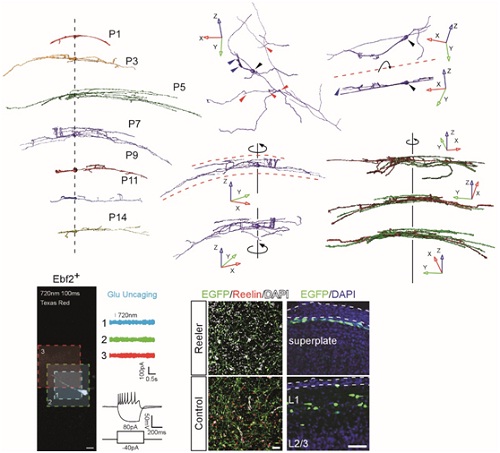New insight into development of Cajal-Retzius cells and early local circuitry
A research article leads by Prof. WANG Xiaoqun at IBP, entitled “Morphological and physiological characteristics of Ebf2-EGFP-expressing Cajal-Retzius cells in developing mouse neocortex” was published online by Cerebral Cortex on October12, 2018. This study provides insights into the rapid maturation and axonal stratification of CR cells in layer 1, and provide the evidence that both the electrophysiological activities and the morphology of CR cells provide vital guidance for the modulation of early circuits, in a Reelin-dependent manner.
Cajal-Retzius (CR) cells were discovered by Ramón y Cajal (1891) and Retzius (1893, 1894) and are one of the earliest neuronal cell types generated during neocortical development. CR cellsparticipate in embryonic and postnatal cortical spontaneous activities and that they form a critical part of the neural networks in the Marginal Zone. They secret Reelin in neocortex and are crucial for both neural migration and neocortical lamination.However, there are still some gaps in research of CR cell development. Especially, the consequence of Reelin-deficiency on development and function of CR cells is still unknow. Also, their axonal distribution pattern and the spatial/temporal pattern of presynaptic inputs to CR cells remains to be elucidated.
To characterize the dynamic morphological properties of CR cells in Ebf2-EGFP mice during neocortical development, this studyperformed 3D reconstruction on images of single CR cell with their own 3D reconstruction workflow. Previous studies suggested the axons of CR cells were confined entirely to layer 1 in a 2D view. The authors revealed that the axons of CR cells stratified in a narrow band in Layer I. Additionally, the neighboring CR cells’ axons occupied the same sublayer. It is significant that specific stratification pattern of CR cells confines their axons to format connections to a specific group of neurons, which added the very important information of understanding how CR involved in early local circuit from the aspects of CR occupation space.
This new study also performed two-photon uncaging on single portion of axon of CR cell. This experiment showed that only GABAergic presynaptic inputs were detected in CR cells.This synaptic strength of CR cells increases from Postnatal day 1 (P1) to P7 and subsequently decreases without regaining its original strength.This result confirm that CR cells participate in early neocortex correlated GABAergic networks, which added completely new information in the field.
This study is the first study to accurately recognize CR cells in Reelin-deficient mice by Ebf2-EGFP labeling. Based on EGFP labeling, the authors were able to systematically figure out the changes of physiological and morphological properties of CR cells without Reelin. Their results demonstrate that soma location and membrane properties of CR cells were not influenced, but the connectivity and axonal stratification of CR cells were disrupted upon Reelin-deficiency. These results demonstrate that CR cells are involved in a functional local circuit depending on Reelin signal, which is novel in the field of CR studies.

Figure. 3D reconstruction of CR cell morphology; Two-photon uncaging; Ebf2 expressed CR cells in Reelin-deficient mice.
The first author is SUN Le and CHEN Ruiguo, and the corresponding author are WANG Xiaoqun(Institute of Biophysics), SUN Le(Institute of Biophysics), WU Qian(Institute of Biophysics) and SHEN Qin(Tongji University).
Article link: https://academic.oup.com/cercor/advance-article/doi/10.1093/cercor/bhy265/5126802
Contact: WANG Xiaoqun, Ph.D, Prof.
Principal Investigator
Vice Director of State Key Laboratory of Brain & Cognitive Sciences, IBP
Function and regulation of neural stem cells in the mammalian brains
E-mail: xiaoqunwang@ibp.ac.cn, Tel:010-64887994
Fax:010-64871293, Zip code: 100101

